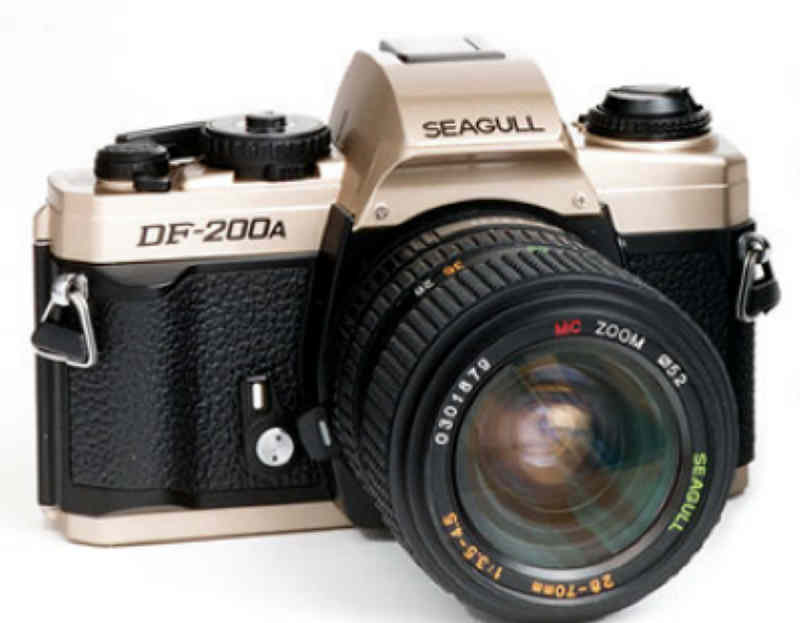
SEAGULL -- AFTER MINOLTA -- NUMBERED UNDER "300"

SEAGULL -- AFTER MINOLTA -- NUMBERED UNDER "300"
These cameras are listed in alphabetic order:

This is a strictly bare-bones, manual exposure-only camera. It
lacks a TTL meter, but because the shutter is electronic, it requires two A76
batteries to operate. It is the same camera as the DF-1000 (not the
DF-100), but in a black body.
This is a Seagull DF-98 with a date back. Like the camera, itself, the back requires a battery (a CR2025), and will imprint the date or the time.

The DF-99 is a DF-98 with a TTL meter added -- but it is strictly a metered-manual-exposure-only camera. It has a built-in TTL meter, but it lacks the auto-exposure of the X-370n. Like the DF-98, it has an electronic shutter and requires batteries. It has an ON/OFF switch to prevent accidental exposures.
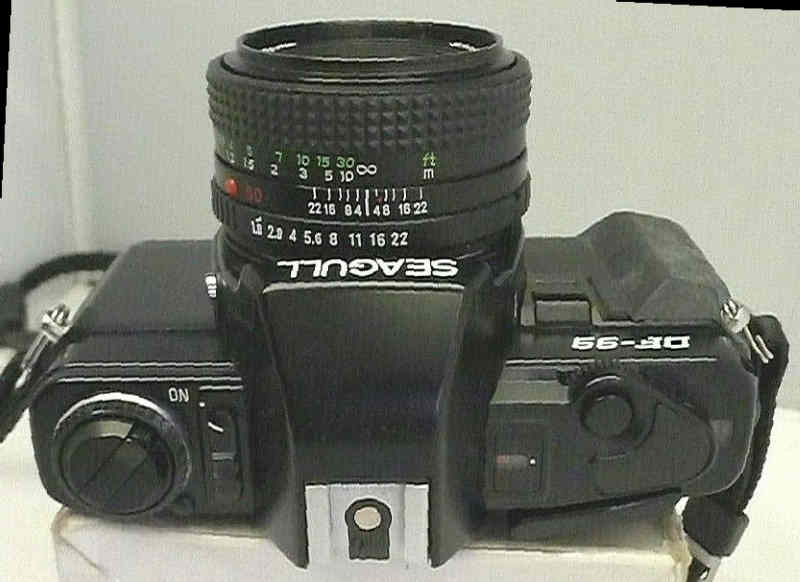
It has three LED's in the viewfinder which indicate the correct exposure as you manually change the shutter speed (1-1/1,000, plus B) and the aperture. The viewfinder has a split-image rangefinder with a micro-prism collar, and shows a RED LED on the top for "over-exposure", a GREEN LED in the middle for "correct exposure", and a YELLOW LED on the bottom for "under-exposure" -- when the plain (non-sensa-switch) shutter release is pressed half-way. No LEDs is the battery check. The shutter is an electronic, quartz-controlled, horizontal-traverse cloth curtain, using two A76 batteries. It uses a silicon, center-weighted meter cell, has a self-timer, hot shoe, and film speeds from 12-3200. In addition, it will not accept a motor drive.
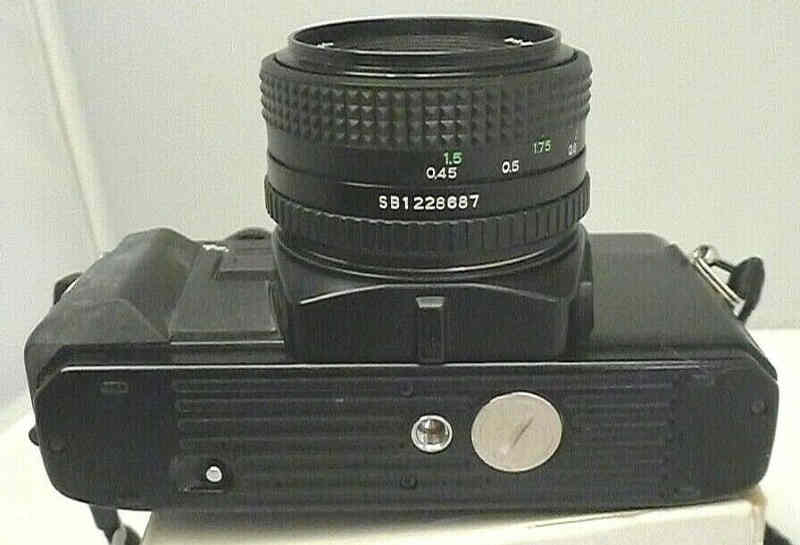
It has a hand grip bump on the back -- as well as a film indicator window:
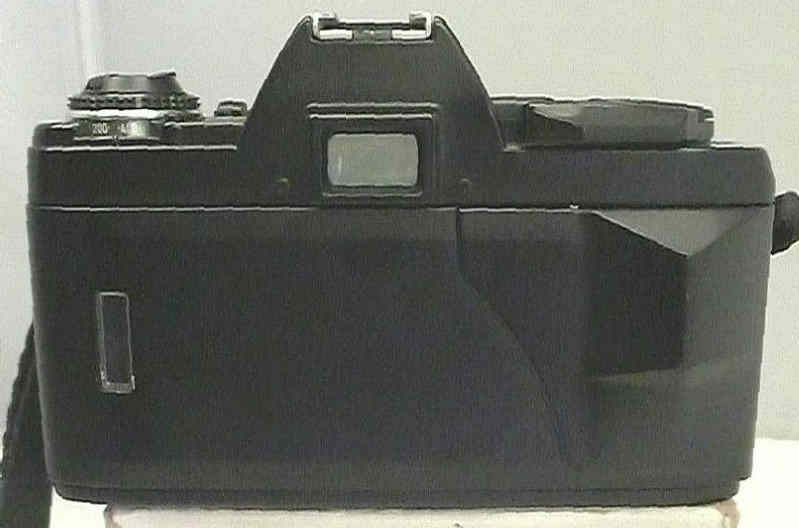
It is the same camera as the Phoenix P-2000 and Kalimar KX 5000.
A Seagull DF-99 with a date back.

This is a Seagull DF-98 with a date back. Like the camera, itself, the back requires a battery (a CR2025), and will imprint the date or the time.
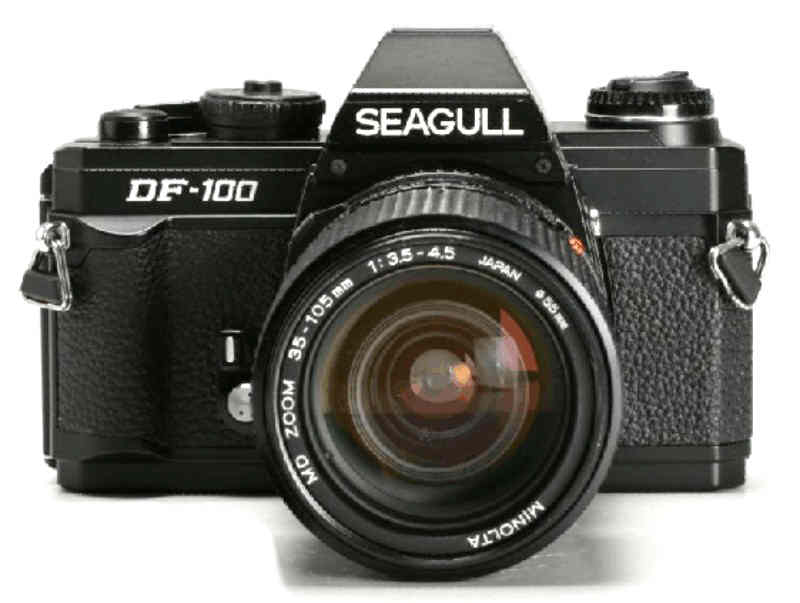
(1996) I'll never know why they didn't call this the Seagull DF- 2000 or
something like that, since it has a top speed of 1/2,000. Maybe it was because
they had already named one of their cameras as the DF-2000! It is strictly
a mechanical camera and doesn't even have a meter, but if you don't need that
feature, this is a great camera. If you need a meter, get a Seagull DF-200,
Braun SR-2000, or Phenix DC-901.
The DF-100 looks like a Minolta X-370, and even has the built-in hand grip on the front and rear.

But two differences stand out. First, is that the DF-100 is missing the standard ON/OFF switch next to the rewind knob.
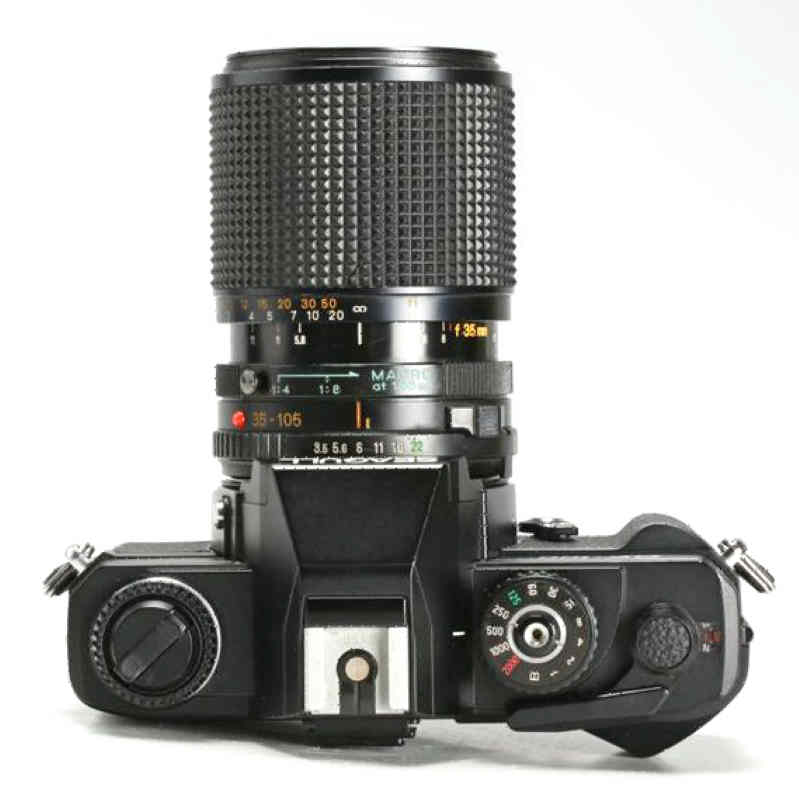
Next, is that the shutter release sticks up out of the shutter speed dial. This is because the DF-100 has a mechanical, vertical-travel, metal-bladed shutter. You read it right. It has a metal shutter that travels vertically -- and doesn't need a battery! It has speeds of B,1-1/2000 sec. You read it right. Top speed of 1/2000! But it is an unmetered, manual exposure only camera. You read it right,. No meter, so there is no other information in the viewfinder. There is however an acute matte focusing screen with central split-image spot surrounded by microprism. It also has a mechanical self-timer of approximately 10 sec.delay, a tripod socket, cable release connection and hot shoe. Despite the fast shutter speed, for some reason there is no option for a motor drive -- as is common with Seagull SLR cameras. This undoubtedly is due to the mechanical, vertical shutter instead of the typical electronic, horizontal shutter.

It has a film speed reminder -- where the ISO is normally set -- but it only runs from 50 to 400. There is also a redundant, cassette read-out window is on the film door. Flash SYNC is at 1/125 sec. and lower. You read it right -- top synch of 1/125 -- but no PC contact.

(1996) A Seagull DF-100 with a data back.
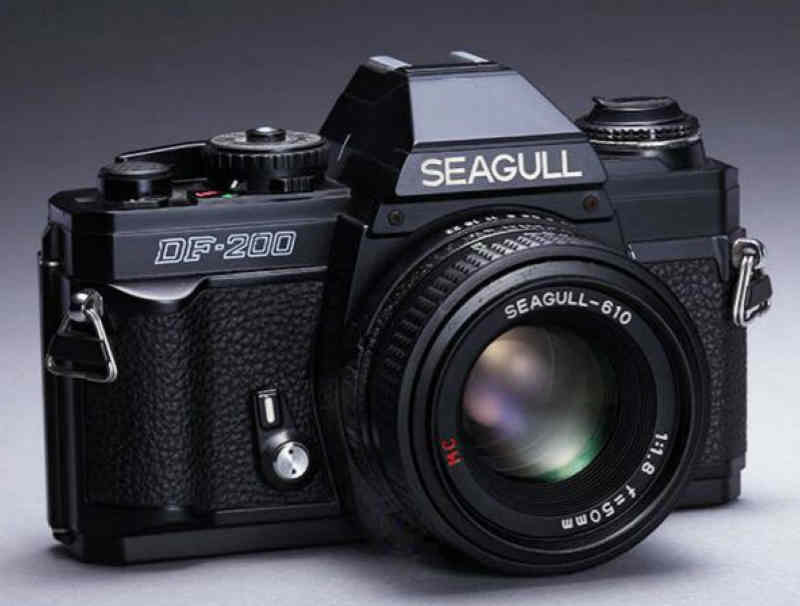
A step up from the DF-100. This model adds a meter. The meter is pretty
basic but works well. It has three LED's for OVER, UNDER and OK. It is strictly
a manual meter and no automatic exposure is available. The vertical-travel
shutter is completely manual and does not need a battery. So if the meter
dies, or the battery is dead, or the meter is not turned on, the camera can
still take a picture.
The DF-200 has a unique ON/OFF switch. First, the switch only controls the meter. It does not turn ON or OFF the camera shutter -- which is mechanical, and operates even when the camera's ON/OFF switch is set to OFF. Also, unlike the earlier DF-1ETM DF-2ETM which have an ON/OFF switch around the film rewind knob -- and close to the battery chamber -- the DF-200 has an ON/OFF switch reminiscent of the ON/OFF switch of the Minolta X-700. It is a small tab on the front of the shutter speed dial which has a white line pointing to either a red OFF or a green ON.
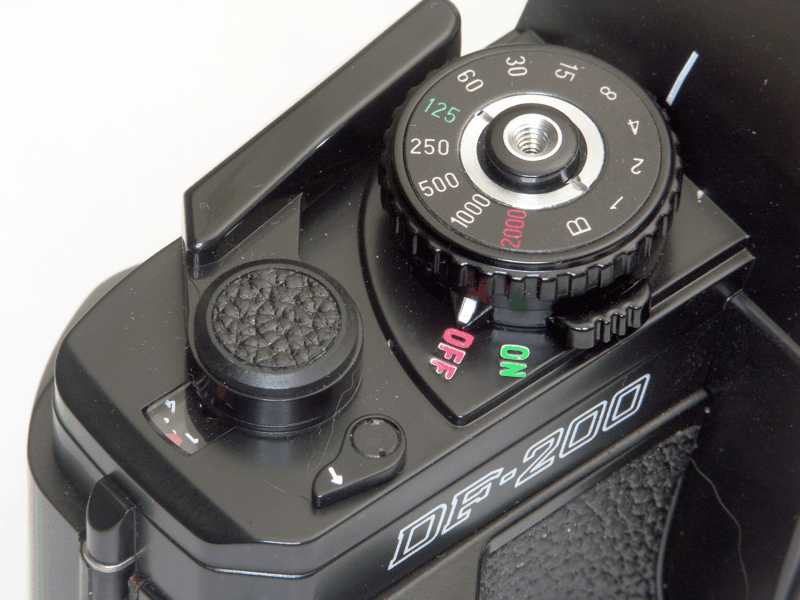
On the X-700, there is a small window on the opposite side of the shutter speed dial that displays either ON or OFF -- not visible in this photo. The small button on the X-700 is not for multiple exposures, as you might think. It releases the shutter speed dial from the locked "P" setting.


The DF-200A has a unique ON/OFF switch. While it is similar to the ON/OFF switch on the DF-200, in that it is a small tab on the front of the shutter speed dial and performs the same function, its two settings are marked differently. When set to OFF, a small GREEN dot appears, and when set to ON, the GREEN dot is covered up -- a RED dot is not displayed, as you might think. Also, the multiple exposure lever is set in the opposite direction as on the DF-200. Instead of pushing the lever forward, as is done on the DF-200, the lever is pointed in the opposite direction, and is pressed backward instead. Works fine, but go figure!
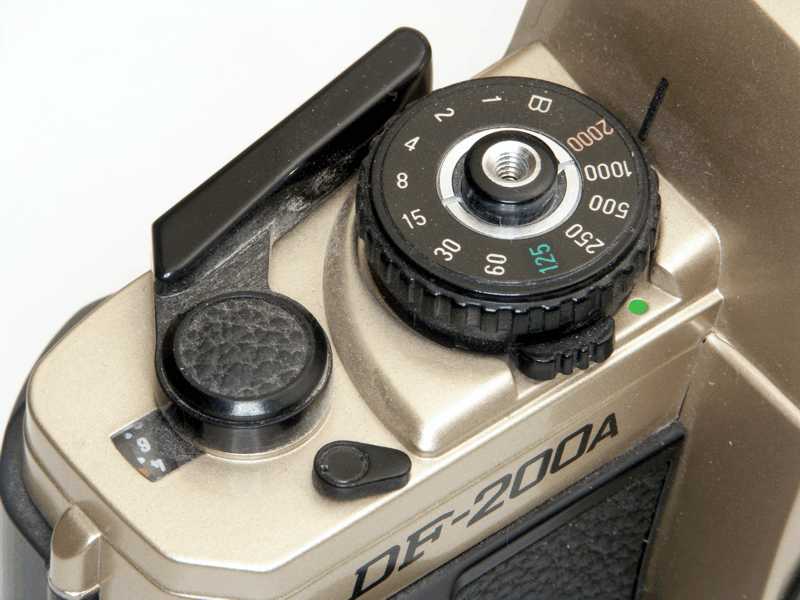

(1996) A Seagull DF-200 with a data back.
SEAGULL X-9
Minolta's last NEW 35mm, SLR camera -- the X-9 -- was made completely, and only, in China (FYI, the last 35mm SLR camera marked "Minolta" and made in China was an X-370). All of them are clearly marked "CHINA" on the bottom -- right next to the serial number.

So I guess it's not too surprising that Seagull simply continued to manufacture the X-9 camera after Minolta stopped making it -- but now with the SEAGULL name on it. It is the exact same camera as the Minolta X-9, but apparently it is the only Seagull SLR camera that used the exact same model designation as the Minolta counterpart. While the Seagull DF-300 is the same camera as the Minolta X-300 -- it was not labeled the Seagull X-300. But the Seagull X-9 was not re-named the Seagull DF-9, as you might expect.


The Seagull X-9 had all of the advanced features of the Minolta X-9, such as a cable release socket, a depth-of-field button,
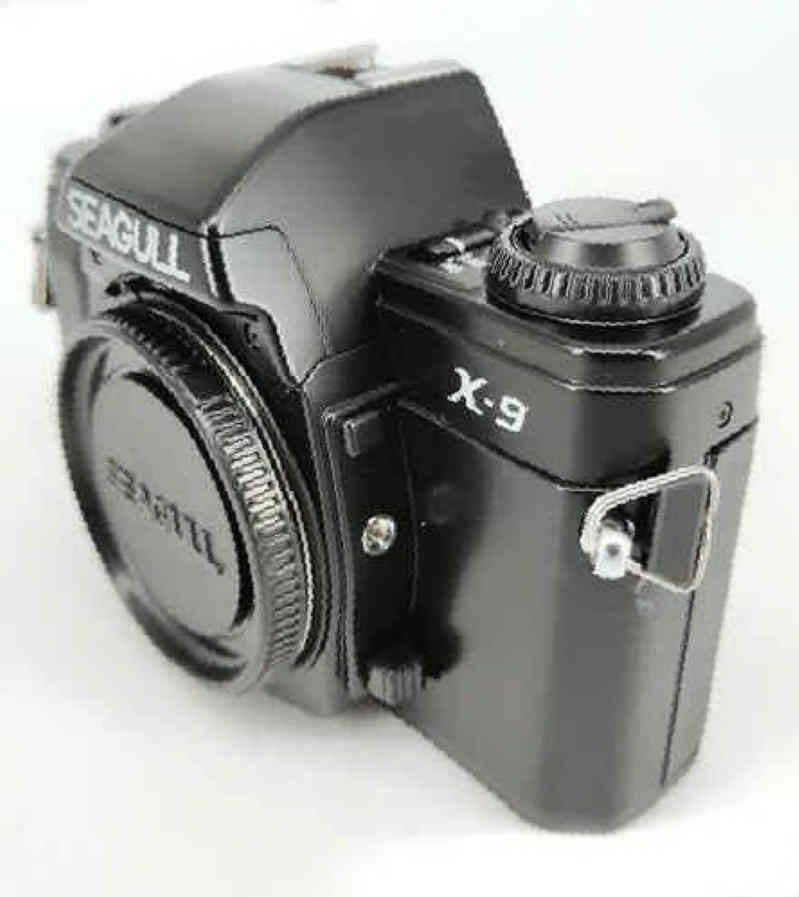
a 45 degree-angle, split-image rangefinder (in the center of the viewfinder), and a dedicated hot shoe. It also has all of the electrical connections for the Minolta Motor Drive 1 -- AND a reduced front handgrip to accomodate it.

It also has full metered manual, and aperture-priority automatic exposure, as well as a self-timer, and convenient exposure lock tab. Not a bad rig, if you can find one!
| Shutter | Shutter speeds |
Flash synch speed |
TTL meter- ing? |
ISO settings |
Auto expo- sure? |
AE lock? |
View- finder info |
Flash shoe |
Sensa- switch? |
PC plug? |
Multi- expo- sure? |
Cable release plug? |
Stop down button? |
Self timer? |
Mirror lock-up? |
Motor drive option? |
Battery used for |
Film indicator |
|
| Seagull DF-300 (model 1) |
cloth, horizontal |
4-1,000 B |
1/60 | Y | 12- 3200 |
Y | Y | Shutter speed scale |
Dedicated | Y | N | N | Y | N | Y | N | Y | meter | Film tab holder |
| Seagull DF-300 (model 2) |
cloth, horizontal |
4-1,000 B |
1/60 | Y | 12- 3200 |
Y | Y | Shutter speed scale |
Dedicated | Y | N | N | Y | N | Y | N | Y | meter | Film window |